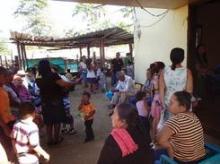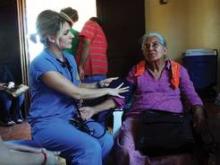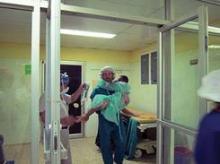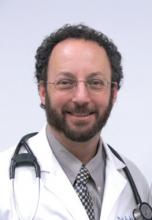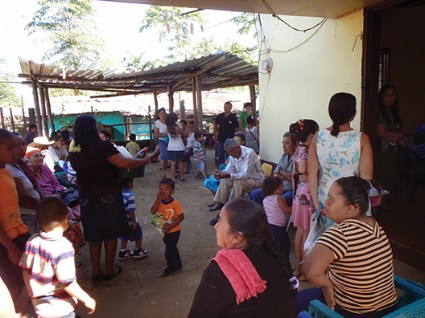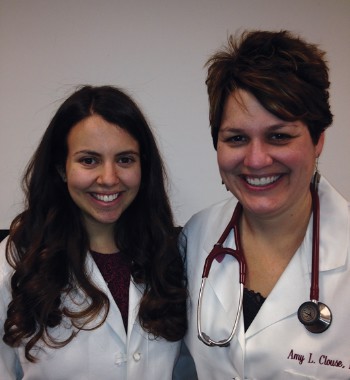User login
Report from the front line: A medical mission in Honduras
The poor are many
and so
impossible to forget.
Roberto Sosa, Honduran poet
In February, 20 physicians, nurses, and other health care personnel – including five members of the Family Medicine Residency Program at Abington (Pa.) Memorial Hospital – Dr. Kate Baranik, Dr. Magan Madsen, Dr. Margarita McDonald, Dr. John Russell, and Dr. Neil Skolnik – boarded a flight to Honduras for a medical mission to provide medical care to those in need there. Only 13% of people in the country have health insurance. The hospital bed ratio is 0.7 beds/1,000 people, as compared with the United States, where the ratio is 3 beds/1,000 people. These statistics make it evident that the health care system in Honduras needs restructuring. Although a group of Americans cannot restructure a whole health care system, the little steps we took in embarking on this journey to provide medical care has made a lasting impact on numerous lives, not least of which are our own.
Operation Heal Honduras was the culmination of 9 years of medical mission trips. What started as a small surgical team blossomed under the organizational leadership of an Abington Memorial Hospital general surgeon, Dr. Seth L. Newman, into a multidisciplinary group now including family medicine, general and trauma surgery, orthopedics, and ob.gyn. In addition to the five attending physicians, this year there were five residents-in-training, three certified registered nurse anesthetists, and multiple RNs and translators. While they vary in quality and cleanliness, Honduras has hospitals, operating rooms, and places to set up a clinic. More difficult is the job of obtaining the disposable items needed to perform operations and solve medical mysteries. Hospitals cannot afford to purchase these things. So the team brought gowns, gloves, sutures, gauze, mesh, casting material, ACE wraps, laparoscopic ports, drapes, and approximately $2,000 worth of medications.
While in Honduras, the team stayed at the Andrew Clinic located 15 miles north of El Progreso; the clinic is run by Dr. Florence Yoon and Dr. David Yoon. El Progreso is notable for its lush green mountains, palm trees, banana plants. On a typical day, the medical team set up a clinic in neighboring villages while the surgical team operated at the hospital in El Progreso.
One day specifically stands out in everyone’s mind. This day, like the others, started early, with a breakfast of scrambled eggs, beans, tortillas, mango, and cantaloupe, after which we left for the hospital and the mission medical clinic at 7 a.m. While driving to the hospital, it was impossible not to notice the poverty: the emaciated man walking on the side of the road with a plastic bag in hand; the muddy unpaved roads, branching off the side of the main road, each lined with wooden shacks with tin roofs; the rusted gutted cars on the side of the road; the Coca-Cola and Pepsi signs everywhere tempting people to spend money that they did not have on soda that they did not need. Everywhere we drove there were soldiers carrying machine guns to prevent crime, which is dramatically high in Honduras.
When we arrived at the hospital, the medical team consulted with the surgical team on a difficult case, and the surgeons were informed that the power to the hospital might be cut off at 8 a.m., as part of routine rotating power outages. It turned out that by 8:30, the power was still on, so the surgeons were able to operate in three operating rooms. The medical team then continued to the small village church where we were to stage a medical clinic. Pulling up to the church, we saw how the people lived in the village. They lived in small huts, with roosters, chickens, and dogs roaming freely in the muddy yards. Laundry was hanging outside each house, and smiling children played in the streets. Still, the medical team felt trepidation as we headed to care for the people in a neighborhood church built 3 years ago in a poor area of San Pedro Sula, the city known as the murder capital of the world.
Arriving, the bus turned into the narrow two-lane dirt street that was barely wider than the bus itself. When we disembarked the bus, we saw about a hundred people, young and old, waiting patiently for us in the church. The team saw about 400 people that day; we injected knees and shoulders, treated pneumonia in a young infant, gave prednisone for asthma, counseled an elderly woman with depression, gave antibiotics for wounds, saw a young child with clubfoot, and helped others who were tired, poor, and had headaches and joint pain. They waited a long time to be seen and receive the medical care we could give in the form of vitamins, antiparasite medications, antibiotics, skin creams, and others. That medical care that would not fix their lives, but it did make their lives a little better by virtue of medicines and knowing that someone cared enough to be there. Their smiles and their "gracias" connected them to us and told us a part of their story that could be told no other way.
Dr. Skolnik is professor of family and community medicine at, Temple University, Philadelphia, and associate director of the family medicine residency program there. Ms. Skolnik attends Drexel University and is a research assistant at the Children’s Hospital of Pennsylvania, both in Philadelphia. Ms. Ogen is a certified registered nurse anesthetist at Abington Memorial Hospital.
*Correction, 3/10/2014: An earlier version of this story misstated Ava Skolnik's name.
The poor are many
and so
impossible to forget.
Roberto Sosa, Honduran poet
In February, 20 physicians, nurses, and other health care personnel – including five members of the Family Medicine Residency Program at Abington (Pa.) Memorial Hospital – Dr. Kate Baranik, Dr. Magan Madsen, Dr. Margarita McDonald, Dr. John Russell, and Dr. Neil Skolnik – boarded a flight to Honduras for a medical mission to provide medical care to those in need there. Only 13% of people in the country have health insurance. The hospital bed ratio is 0.7 beds/1,000 people, as compared with the United States, where the ratio is 3 beds/1,000 people. These statistics make it evident that the health care system in Honduras needs restructuring. Although a group of Americans cannot restructure a whole health care system, the little steps we took in embarking on this journey to provide medical care has made a lasting impact on numerous lives, not least of which are our own.
Operation Heal Honduras was the culmination of 9 years of medical mission trips. What started as a small surgical team blossomed under the organizational leadership of an Abington Memorial Hospital general surgeon, Dr. Seth L. Newman, into a multidisciplinary group now including family medicine, general and trauma surgery, orthopedics, and ob.gyn. In addition to the five attending physicians, this year there were five residents-in-training, three certified registered nurse anesthetists, and multiple RNs and translators. While they vary in quality and cleanliness, Honduras has hospitals, operating rooms, and places to set up a clinic. More difficult is the job of obtaining the disposable items needed to perform operations and solve medical mysteries. Hospitals cannot afford to purchase these things. So the team brought gowns, gloves, sutures, gauze, mesh, casting material, ACE wraps, laparoscopic ports, drapes, and approximately $2,000 worth of medications.
While in Honduras, the team stayed at the Andrew Clinic located 15 miles north of El Progreso; the clinic is run by Dr. Florence Yoon and Dr. David Yoon. El Progreso is notable for its lush green mountains, palm trees, banana plants. On a typical day, the medical team set up a clinic in neighboring villages while the surgical team operated at the hospital in El Progreso.
One day specifically stands out in everyone’s mind. This day, like the others, started early, with a breakfast of scrambled eggs, beans, tortillas, mango, and cantaloupe, after which we left for the hospital and the mission medical clinic at 7 a.m. While driving to the hospital, it was impossible not to notice the poverty: the emaciated man walking on the side of the road with a plastic bag in hand; the muddy unpaved roads, branching off the side of the main road, each lined with wooden shacks with tin roofs; the rusted gutted cars on the side of the road; the Coca-Cola and Pepsi signs everywhere tempting people to spend money that they did not have on soda that they did not need. Everywhere we drove there were soldiers carrying machine guns to prevent crime, which is dramatically high in Honduras.
When we arrived at the hospital, the medical team consulted with the surgical team on a difficult case, and the surgeons were informed that the power to the hospital might be cut off at 8 a.m., as part of routine rotating power outages. It turned out that by 8:30, the power was still on, so the surgeons were able to operate in three operating rooms. The medical team then continued to the small village church where we were to stage a medical clinic. Pulling up to the church, we saw how the people lived in the village. They lived in small huts, with roosters, chickens, and dogs roaming freely in the muddy yards. Laundry was hanging outside each house, and smiling children played in the streets. Still, the medical team felt trepidation as we headed to care for the people in a neighborhood church built 3 years ago in a poor area of San Pedro Sula, the city known as the murder capital of the world.
Arriving, the bus turned into the narrow two-lane dirt street that was barely wider than the bus itself. When we disembarked the bus, we saw about a hundred people, young and old, waiting patiently for us in the church. The team saw about 400 people that day; we injected knees and shoulders, treated pneumonia in a young infant, gave prednisone for asthma, counseled an elderly woman with depression, gave antibiotics for wounds, saw a young child with clubfoot, and helped others who were tired, poor, and had headaches and joint pain. They waited a long time to be seen and receive the medical care we could give in the form of vitamins, antiparasite medications, antibiotics, skin creams, and others. That medical care that would not fix their lives, but it did make their lives a little better by virtue of medicines and knowing that someone cared enough to be there. Their smiles and their "gracias" connected them to us and told us a part of their story that could be told no other way.
Dr. Skolnik is professor of family and community medicine at, Temple University, Philadelphia, and associate director of the family medicine residency program there. Ms. Skolnik attends Drexel University and is a research assistant at the Children’s Hospital of Pennsylvania, both in Philadelphia. Ms. Ogen is a certified registered nurse anesthetist at Abington Memorial Hospital.
*Correction, 3/10/2014: An earlier version of this story misstated Ava Skolnik's name.
The poor are many
and so
impossible to forget.
Roberto Sosa, Honduran poet
In February, 20 physicians, nurses, and other health care personnel – including five members of the Family Medicine Residency Program at Abington (Pa.) Memorial Hospital – Dr. Kate Baranik, Dr. Magan Madsen, Dr. Margarita McDonald, Dr. John Russell, and Dr. Neil Skolnik – boarded a flight to Honduras for a medical mission to provide medical care to those in need there. Only 13% of people in the country have health insurance. The hospital bed ratio is 0.7 beds/1,000 people, as compared with the United States, where the ratio is 3 beds/1,000 people. These statistics make it evident that the health care system in Honduras needs restructuring. Although a group of Americans cannot restructure a whole health care system, the little steps we took in embarking on this journey to provide medical care has made a lasting impact on numerous lives, not least of which are our own.
Operation Heal Honduras was the culmination of 9 years of medical mission trips. What started as a small surgical team blossomed under the organizational leadership of an Abington Memorial Hospital general surgeon, Dr. Seth L. Newman, into a multidisciplinary group now including family medicine, general and trauma surgery, orthopedics, and ob.gyn. In addition to the five attending physicians, this year there were five residents-in-training, three certified registered nurse anesthetists, and multiple RNs and translators. While they vary in quality and cleanliness, Honduras has hospitals, operating rooms, and places to set up a clinic. More difficult is the job of obtaining the disposable items needed to perform operations and solve medical mysteries. Hospitals cannot afford to purchase these things. So the team brought gowns, gloves, sutures, gauze, mesh, casting material, ACE wraps, laparoscopic ports, drapes, and approximately $2,000 worth of medications.
While in Honduras, the team stayed at the Andrew Clinic located 15 miles north of El Progreso; the clinic is run by Dr. Florence Yoon and Dr. David Yoon. El Progreso is notable for its lush green mountains, palm trees, banana plants. On a typical day, the medical team set up a clinic in neighboring villages while the surgical team operated at the hospital in El Progreso.
One day specifically stands out in everyone’s mind. This day, like the others, started early, with a breakfast of scrambled eggs, beans, tortillas, mango, and cantaloupe, after which we left for the hospital and the mission medical clinic at 7 a.m. While driving to the hospital, it was impossible not to notice the poverty: the emaciated man walking on the side of the road with a plastic bag in hand; the muddy unpaved roads, branching off the side of the main road, each lined with wooden shacks with tin roofs; the rusted gutted cars on the side of the road; the Coca-Cola and Pepsi signs everywhere tempting people to spend money that they did not have on soda that they did not need. Everywhere we drove there were soldiers carrying machine guns to prevent crime, which is dramatically high in Honduras.
When we arrived at the hospital, the medical team consulted with the surgical team on a difficult case, and the surgeons were informed that the power to the hospital might be cut off at 8 a.m., as part of routine rotating power outages. It turned out that by 8:30, the power was still on, so the surgeons were able to operate in three operating rooms. The medical team then continued to the small village church where we were to stage a medical clinic. Pulling up to the church, we saw how the people lived in the village. They lived in small huts, with roosters, chickens, and dogs roaming freely in the muddy yards. Laundry was hanging outside each house, and smiling children played in the streets. Still, the medical team felt trepidation as we headed to care for the people in a neighborhood church built 3 years ago in a poor area of San Pedro Sula, the city known as the murder capital of the world.
Arriving, the bus turned into the narrow two-lane dirt street that was barely wider than the bus itself. When we disembarked the bus, we saw about a hundred people, young and old, waiting patiently for us in the church. The team saw about 400 people that day; we injected knees and shoulders, treated pneumonia in a young infant, gave prednisone for asthma, counseled an elderly woman with depression, gave antibiotics for wounds, saw a young child with clubfoot, and helped others who were tired, poor, and had headaches and joint pain. They waited a long time to be seen and receive the medical care we could give in the form of vitamins, antiparasite medications, antibiotics, skin creams, and others. That medical care that would not fix their lives, but it did make their lives a little better by virtue of medicines and knowing that someone cared enough to be there. Their smiles and their "gracias" connected them to us and told us a part of their story that could be told no other way.
Dr. Skolnik is professor of family and community medicine at, Temple University, Philadelphia, and associate director of the family medicine residency program there. Ms. Skolnik attends Drexel University and is a research assistant at the Children’s Hospital of Pennsylvania, both in Philadelphia. Ms. Ogen is a certified registered nurse anesthetist at Abington Memorial Hospital.
*Correction, 3/10/2014: An earlier version of this story misstated Ava Skolnik's name.
Screening for intimate partner violence and abuse of elderly and vulnerable adults
The U.S. Preventive Services Task Force has released updated recommendations regarding screening for intimate partner violence and abuse of elderly and vulnerable adults. While their previous recommendations in 2004 gave intimate partner violence screening an "I" recommendation, meaning that the evidence was inconclusive regarding the balance of benefits and intimate partner violence harms, the current recommendation has been upgraded to a "B" recommendation, meaning there is moderate certainty that there is a net benefit from screening. This puts the USPSTF recommendation in alignment with those of most other groups, including the American Medical Association and the *American College of Obstetricians and Gynecologists.
Forms of abuse
The recommendations regarding intimate partner violence in these guidelines refer to physical, sexual, or psychological abuse of women of reproductive age by a current or former partner or spouse. The issue of intimate partner violence is important because research shows that approximately 31% of women and 26% of men have experienced intimate partner violence within their lifetime, and that intimate partner violence is usually undetected. It is also estimated that these numbers are likely to be low because of underreporting. In one large study, the 1-year incidence of abuse was 8% within the last year and 15% within the last 5 years. Approximately 1.5%-5% of pregnant women report being abused. Among older and vulnerable adults, the rate of physical, psychological, or sexual abuse; neglect; or financial exploitation is estimated to be between 2% and 10%.
Intimate partner violence has important and long-lasting effects on victims. Harmful effects include immediate injuries resulting from direct trauma as well as long-term physical and mental health consequences. Long-term physical consequences include sexually transmitted diseases, unintended pregnancy, and worse pregnancy outcomes, as well as higher rates of chronic pain, gastrointestinal disorders, migraine headaches, and disability. Long-term mental health consequences include depression, post-traumatic stress disorder, anxiety disorders, substance abuse, and a higher rate of suicide.
Screening of women
Intimate partner violence in women can be detected with a high level of certainty. There are specific factors that can influence the chances that an individual is at risk for intimate partner violence and can alert clinicians to have increased vigilance for abuse. These risk factors have four categories. The first category is individual, focusing on an individual’s self-esteem. The second is relationship, which focuses on marriage conflict and stability within relationships. Third is community, which is looking at socioeconomic background. Fourth are the societal factors of traditional gender roles.
Many screening instruments exist that have been carefully studied. For instance, the HITS instrument, available in English and Spanish, is a four-item questionnaire that asks about being hurt, insulted, screamed at, or threatened. In one study, it had a sensitivity of 86% and a specificity of 99% for detecting intimate partner violence. The interval for screening is not clear.
Treatment
Once intimate partner violence among women is detected, many approaches are available to help these women. For example, one trial was set up to test the effectiveness of a mentoring support group vs. usual care. All women who entered this trial had discussed intimate partner violence with their primary care physician. After the intervention program, the women who were in the intervention group had significantly reduced scores of abuse as opposed to the comparison group. Another example is a study of pregnant women who reported abuse, who were then randomized to a counseling intervention vs. usual care. Women in the counseling group had decreased pregnancy coercion and were more likely to discontinue an unhealthy or unsafe relationship.
Approaches vary from counseling to social work interventions brought to peoples’ homes, information cards, referral to community services, and mentoring support services. It appears that varied interventions decrease recurrent abuse. There is no reported harm in screening for intimate partner violence. It is necessary for the primary care doctor to be aware of the laws specific to intimate partner violence reporting and privacy within the doctor’s specific region.
Elderly and vulnerable adults
In contrast to screening for intimate partner violence in women, there is a lack of evidence for abuse screening in elderly and vulnerable adult populations. There is a lack of evidence on the benefits of detection and, surprisingly, a lack of evidence on the benefits of early intervention. It is also possible that the harms of detecting abuse in this group may be different, although the risk appears to be small. Some potential harm includes shame, guilt, fear of retaliation, and abandonment by caretakers who have been accused of abuse.
While the evidence to support screening elderly and vulnerable adults is limited, state and local laws vary about the obligation and logistics of reporting elderly abuse. A main conclusion of the USPSTF is that more evidence-based research needs to be done for the population of elderly and vulnerable adults.
Bottom line
Intimate partner violence is common, affecting a quarter of all adults at some point in their life. The mental and physical effects of intimate partner violence can be severe and long-lasting. Screening for intimate partner violence is effective, and effective interventions can be carried out to help women who are victims of intimate partner violence. The USPSTF recommends routine screening of women of reproductive age for intimate partner violence. The data on screening for abuse in the elderly and vulnerable adults is insufficient for the USPSTF to make a recommendation for or against screening.
Reference
• Screening for Intimate Partner Violence and Abuse of Elderly and Vulnerable Adults: U.S. Preventive Services Task Force Recommendation Statement. (Ann. Intern. Med. 2013:158;478-86).
Ms. Skolnik attends Drexel University, Philadelphia, and is a research assistant at the Children’s Hospital of Pennsylvania. Dr. Clouse is an associate director of the family medicine residency program at Abington (Pa.) Memorial Hospital.
*Correction 1/23/14: A previous version of this article misstated the name of the American College of Obstetricians and Gynecologists. This version has been updated.
The U.S. Preventive Services Task Force has released updated recommendations regarding screening for intimate partner violence and abuse of elderly and vulnerable adults. While their previous recommendations in 2004 gave intimate partner violence screening an "I" recommendation, meaning that the evidence was inconclusive regarding the balance of benefits and intimate partner violence harms, the current recommendation has been upgraded to a "B" recommendation, meaning there is moderate certainty that there is a net benefit from screening. This puts the USPSTF recommendation in alignment with those of most other groups, including the American Medical Association and the *American College of Obstetricians and Gynecologists.
Forms of abuse
The recommendations regarding intimate partner violence in these guidelines refer to physical, sexual, or psychological abuse of women of reproductive age by a current or former partner or spouse. The issue of intimate partner violence is important because research shows that approximately 31% of women and 26% of men have experienced intimate partner violence within their lifetime, and that intimate partner violence is usually undetected. It is also estimated that these numbers are likely to be low because of underreporting. In one large study, the 1-year incidence of abuse was 8% within the last year and 15% within the last 5 years. Approximately 1.5%-5% of pregnant women report being abused. Among older and vulnerable adults, the rate of physical, psychological, or sexual abuse; neglect; or financial exploitation is estimated to be between 2% and 10%.
Intimate partner violence has important and long-lasting effects on victims. Harmful effects include immediate injuries resulting from direct trauma as well as long-term physical and mental health consequences. Long-term physical consequences include sexually transmitted diseases, unintended pregnancy, and worse pregnancy outcomes, as well as higher rates of chronic pain, gastrointestinal disorders, migraine headaches, and disability. Long-term mental health consequences include depression, post-traumatic stress disorder, anxiety disorders, substance abuse, and a higher rate of suicide.
Screening of women
Intimate partner violence in women can be detected with a high level of certainty. There are specific factors that can influence the chances that an individual is at risk for intimate partner violence and can alert clinicians to have increased vigilance for abuse. These risk factors have four categories. The first category is individual, focusing on an individual’s self-esteem. The second is relationship, which focuses on marriage conflict and stability within relationships. Third is community, which is looking at socioeconomic background. Fourth are the societal factors of traditional gender roles.
Many screening instruments exist that have been carefully studied. For instance, the HITS instrument, available in English and Spanish, is a four-item questionnaire that asks about being hurt, insulted, screamed at, or threatened. In one study, it had a sensitivity of 86% and a specificity of 99% for detecting intimate partner violence. The interval for screening is not clear.
Treatment
Once intimate partner violence among women is detected, many approaches are available to help these women. For example, one trial was set up to test the effectiveness of a mentoring support group vs. usual care. All women who entered this trial had discussed intimate partner violence with their primary care physician. After the intervention program, the women who were in the intervention group had significantly reduced scores of abuse as opposed to the comparison group. Another example is a study of pregnant women who reported abuse, who were then randomized to a counseling intervention vs. usual care. Women in the counseling group had decreased pregnancy coercion and were more likely to discontinue an unhealthy or unsafe relationship.
Approaches vary from counseling to social work interventions brought to peoples’ homes, information cards, referral to community services, and mentoring support services. It appears that varied interventions decrease recurrent abuse. There is no reported harm in screening for intimate partner violence. It is necessary for the primary care doctor to be aware of the laws specific to intimate partner violence reporting and privacy within the doctor’s specific region.
Elderly and vulnerable adults
In contrast to screening for intimate partner violence in women, there is a lack of evidence for abuse screening in elderly and vulnerable adult populations. There is a lack of evidence on the benefits of detection and, surprisingly, a lack of evidence on the benefits of early intervention. It is also possible that the harms of detecting abuse in this group may be different, although the risk appears to be small. Some potential harm includes shame, guilt, fear of retaliation, and abandonment by caretakers who have been accused of abuse.
While the evidence to support screening elderly and vulnerable adults is limited, state and local laws vary about the obligation and logistics of reporting elderly abuse. A main conclusion of the USPSTF is that more evidence-based research needs to be done for the population of elderly and vulnerable adults.
Bottom line
Intimate partner violence is common, affecting a quarter of all adults at some point in their life. The mental and physical effects of intimate partner violence can be severe and long-lasting. Screening for intimate partner violence is effective, and effective interventions can be carried out to help women who are victims of intimate partner violence. The USPSTF recommends routine screening of women of reproductive age for intimate partner violence. The data on screening for abuse in the elderly and vulnerable adults is insufficient for the USPSTF to make a recommendation for or against screening.
Reference
• Screening for Intimate Partner Violence and Abuse of Elderly and Vulnerable Adults: U.S. Preventive Services Task Force Recommendation Statement. (Ann. Intern. Med. 2013:158;478-86).
Ms. Skolnik attends Drexel University, Philadelphia, and is a research assistant at the Children’s Hospital of Pennsylvania. Dr. Clouse is an associate director of the family medicine residency program at Abington (Pa.) Memorial Hospital.
*Correction 1/23/14: A previous version of this article misstated the name of the American College of Obstetricians and Gynecologists. This version has been updated.
The U.S. Preventive Services Task Force has released updated recommendations regarding screening for intimate partner violence and abuse of elderly and vulnerable adults. While their previous recommendations in 2004 gave intimate partner violence screening an "I" recommendation, meaning that the evidence was inconclusive regarding the balance of benefits and intimate partner violence harms, the current recommendation has been upgraded to a "B" recommendation, meaning there is moderate certainty that there is a net benefit from screening. This puts the USPSTF recommendation in alignment with those of most other groups, including the American Medical Association and the *American College of Obstetricians and Gynecologists.
Forms of abuse
The recommendations regarding intimate partner violence in these guidelines refer to physical, sexual, or psychological abuse of women of reproductive age by a current or former partner or spouse. The issue of intimate partner violence is important because research shows that approximately 31% of women and 26% of men have experienced intimate partner violence within their lifetime, and that intimate partner violence is usually undetected. It is also estimated that these numbers are likely to be low because of underreporting. In one large study, the 1-year incidence of abuse was 8% within the last year and 15% within the last 5 years. Approximately 1.5%-5% of pregnant women report being abused. Among older and vulnerable adults, the rate of physical, psychological, or sexual abuse; neglect; or financial exploitation is estimated to be between 2% and 10%.
Intimate partner violence has important and long-lasting effects on victims. Harmful effects include immediate injuries resulting from direct trauma as well as long-term physical and mental health consequences. Long-term physical consequences include sexually transmitted diseases, unintended pregnancy, and worse pregnancy outcomes, as well as higher rates of chronic pain, gastrointestinal disorders, migraine headaches, and disability. Long-term mental health consequences include depression, post-traumatic stress disorder, anxiety disorders, substance abuse, and a higher rate of suicide.
Screening of women
Intimate partner violence in women can be detected with a high level of certainty. There are specific factors that can influence the chances that an individual is at risk for intimate partner violence and can alert clinicians to have increased vigilance for abuse. These risk factors have four categories. The first category is individual, focusing on an individual’s self-esteem. The second is relationship, which focuses on marriage conflict and stability within relationships. Third is community, which is looking at socioeconomic background. Fourth are the societal factors of traditional gender roles.
Many screening instruments exist that have been carefully studied. For instance, the HITS instrument, available in English and Spanish, is a four-item questionnaire that asks about being hurt, insulted, screamed at, or threatened. In one study, it had a sensitivity of 86% and a specificity of 99% for detecting intimate partner violence. The interval for screening is not clear.
Treatment
Once intimate partner violence among women is detected, many approaches are available to help these women. For example, one trial was set up to test the effectiveness of a mentoring support group vs. usual care. All women who entered this trial had discussed intimate partner violence with their primary care physician. After the intervention program, the women who were in the intervention group had significantly reduced scores of abuse as opposed to the comparison group. Another example is a study of pregnant women who reported abuse, who were then randomized to a counseling intervention vs. usual care. Women in the counseling group had decreased pregnancy coercion and were more likely to discontinue an unhealthy or unsafe relationship.
Approaches vary from counseling to social work interventions brought to peoples’ homes, information cards, referral to community services, and mentoring support services. It appears that varied interventions decrease recurrent abuse. There is no reported harm in screening for intimate partner violence. It is necessary for the primary care doctor to be aware of the laws specific to intimate partner violence reporting and privacy within the doctor’s specific region.
Elderly and vulnerable adults
In contrast to screening for intimate partner violence in women, there is a lack of evidence for abuse screening in elderly and vulnerable adult populations. There is a lack of evidence on the benefits of detection and, surprisingly, a lack of evidence on the benefits of early intervention. It is also possible that the harms of detecting abuse in this group may be different, although the risk appears to be small. Some potential harm includes shame, guilt, fear of retaliation, and abandonment by caretakers who have been accused of abuse.
While the evidence to support screening elderly and vulnerable adults is limited, state and local laws vary about the obligation and logistics of reporting elderly abuse. A main conclusion of the USPSTF is that more evidence-based research needs to be done for the population of elderly and vulnerable adults.
Bottom line
Intimate partner violence is common, affecting a quarter of all adults at some point in their life. The mental and physical effects of intimate partner violence can be severe and long-lasting. Screening for intimate partner violence is effective, and effective interventions can be carried out to help women who are victims of intimate partner violence. The USPSTF recommends routine screening of women of reproductive age for intimate partner violence. The data on screening for abuse in the elderly and vulnerable adults is insufficient for the USPSTF to make a recommendation for or against screening.
Reference
• Screening for Intimate Partner Violence and Abuse of Elderly and Vulnerable Adults: U.S. Preventive Services Task Force Recommendation Statement. (Ann. Intern. Med. 2013:158;478-86).
Ms. Skolnik attends Drexel University, Philadelphia, and is a research assistant at the Children’s Hospital of Pennsylvania. Dr. Clouse is an associate director of the family medicine residency program at Abington (Pa.) Memorial Hospital.
*Correction 1/23/14: A previous version of this article misstated the name of the American College of Obstetricians and Gynecologists. This version has been updated.
